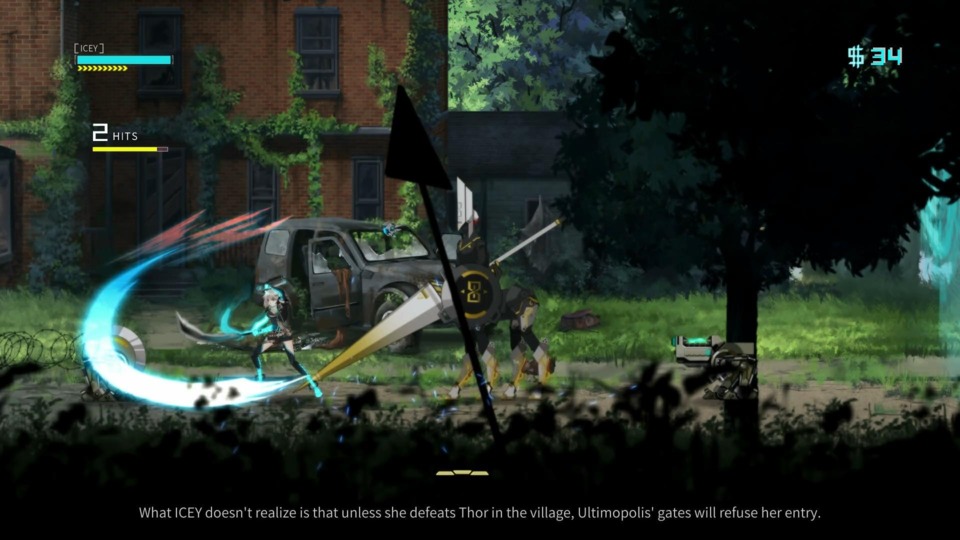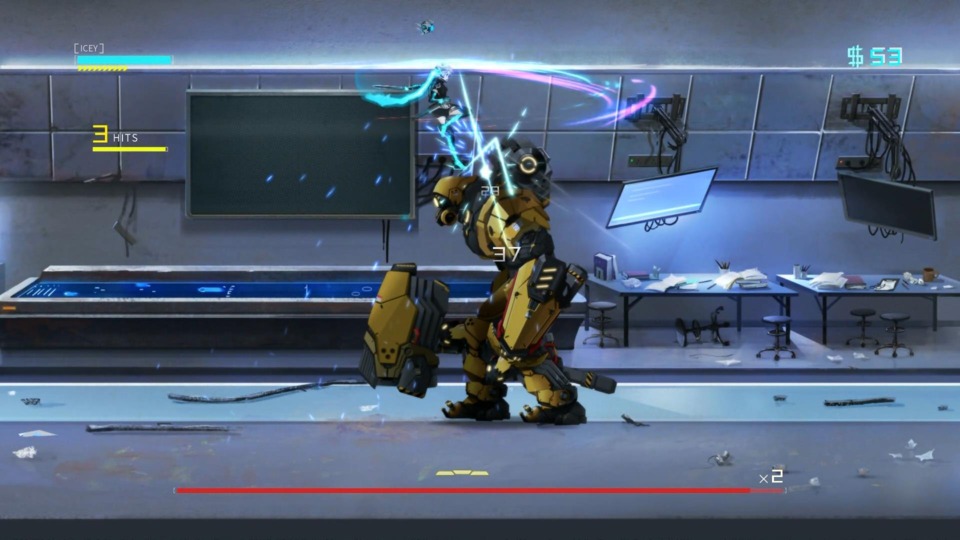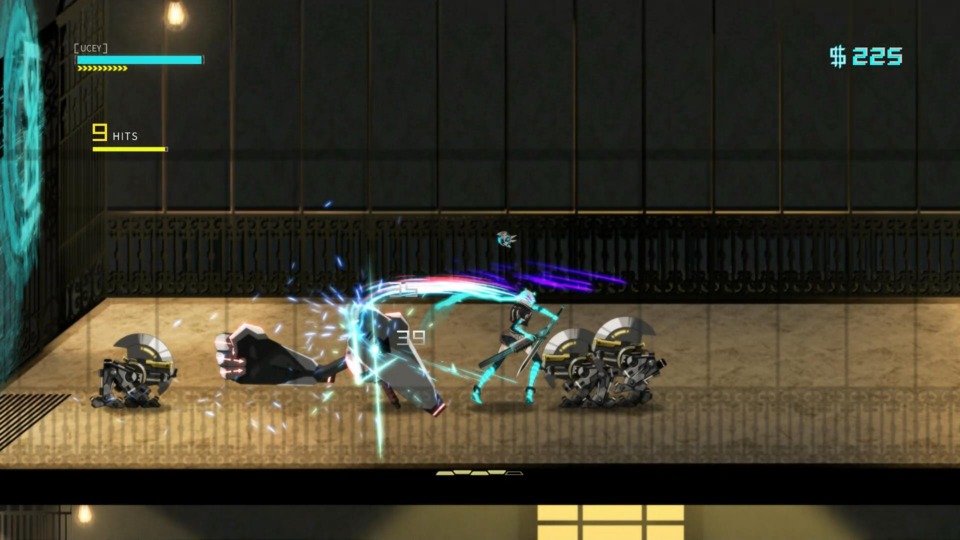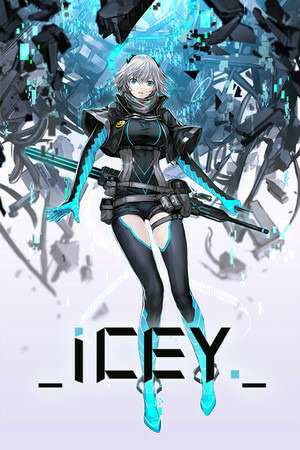ICEY - Review
You can also watch this review instead of reading it.
https://youtu.be/9PRw-Qd0QyA
ICEY is an action game developed by the Chinese indie group Shanghai FantaBlade, and was originally released on Steam in November of 2016. It’s a hack n’ slash that’s similar in vibe to Muramasa or BloodRayne: Betrayal. You fight your way through hordes of enemies on a 2D plane, but ICEY, tries to inject a little bit more personality into it by creating a meta-narrative with a self-aware narrator.
I’ve never been a huge fan of using meta-narrative in games. The tongue-in-cheek humor that comes from 4th wall breaks or seemingly sentient NPCs is present in a lot of things. It’s only when you start to base your entire game around that self-awareness that you need to be ready to dig into it, or otherwise it begins to get dull. The problem is that you can only do this type of thing once. The surprise of realizing you don’t have to follow what you’re told gets old very quickly. The most popular example of what I’m talking about here is The Stanley Parable, which is about the player meeting or going against the expectations of a narrator, and ICEY take a very similar approach.
In between machine slaughter sessions the narrator will wistfully chime in about how the titular robot-girl ICEY is supposed to follow the on-screen flashing arrows to reach her next objective. If you follow the narrator you get a typical hack n slash action game with an annoying and repetitive story. If you choose to not follow the narrator you get to delve a little deeper into some of the more odd things about the game’s world, most notably you get some backstory to the monsters you’re up against.

There’s plenty of boss fights and other oddities locked behind the path less arrow’d. Sometimes these things are kind of cool, like the game completely changing genres and turning into platformer. But most of the time these sections just end up being hidden bosses or the narrator ranting at the player for a few minutes. The meta-narrative is a lot about player expectations versus outcome, and it’s hard to write around this because different players will choose different outcomes for different reasons. The narrator would commonly fall back on accusing me of screwing with him when I would choose to not follow along the path he lined out, but really I just enjoyed exploring the other areas I had access to.
There are some interesting meta-ideas here. For one, the game goes through level select like you’re running through an old computer, or I guess the mind of ICEY. Actions are stored behind .bin and .exe files, which is an interesting and cool way to present this kind of stuff. It also makes sense when things start to go off the rails a bit, because it’s like you’re accessing corrupted data. I really wish the game had pushed this simulation/level select deal harder with its wall breaks rather than try to rest on simply pointing out how you’re breaking linear game conventions.
Once you move this meta stuff out of the way, you’re left with a somewhat average action game experience. ICEY has two sets of attacks, light and heavy. Every combo she uses revolves around these two buttons. It makes for great and simple combat, and there’s a fine variety of options between your ground and air-based combos. It is very easy to get locked into a few certain moves as you progress though, since some attacks much outweigh others in terms usefulness.

While there are optimal combos, there are rarely optimal scenarios to use them in. ICEY doesn’t play fair when it comes to its defensive options. Blocking is non-existent outside of enemies that use it, and the dodge your character has is finicky at best. ICEY has a limited amount of dashes she can use in and out of combat, and they recharge on a cooldown meter. You’re not invulnerable during the startup or recovery animation of your dashes, so you can get hit by enemies at just about any time. The enemy AI can also combo you like you can them, but with much less finesse. It’s easy to get stuck in knockdown loops off of screens of huge enemies, and even some bosses will easily throw you into attack spam that removes 50-80% of your life bar.
There are a few counter balances to deal with the over punishing AI. The first is that ICEY heals off of every enemy she kills with a finishing move, which are always prompted for the player. The other main defensive option is doing a perfect dodge, but it’s hard to determine when exactly you need to do these. Sometimes it’s right before an attack would hit, and others it feels like when an enemies attack animation starts regardless of if you’re in range of them or not. It’s a little frustrating to deal with since these counters can also heal you. Overall, the combat is fast paced, but it lacks a level of polish in certain aspects, mostly in your survivability.

The boss fights are the real draw of the game, at least for me. Most of the fights come down to spacing and patience. You can counter with dash attacks like you can enemies, but with the finickiness of the counter it’s sometimes easier to just try and dodge attacks instead. You have to learn the windows each boss gives you for an attack because they can easily wipe your health bar in a few seconds. What I enjoy most about these bosses is their designs, though. You start out fighting large robots, but the closer you get to the end the more monstrous and humanoid they begin to become. A lot of these things tie into the story hidden under the meta-narrative. There’s an odd amount of Lovecraft involved in the story, but it’s not necessarily reflected in the game visually or atmospherically. Even though I love the colors and builds of the bosses, I wish they would reflect more of the strange and the occult the farther in you get, because that’s the story the game is pushing for.
Overall ICEY feels rather average. It’s a pretty easy to pick up hack n’ slash, with its difficulty being tied to its limited defensive options and sometimes unforgiving AI. You’ll need a good bit of patience to get through the last encounters just on how stupid the enemy spawns get. The meta-narrative behind the game can lead to some interesting encounters and extras, but a lot of times it just ends up feeling like preachy messages on game design. ICEY is currently available on PSN for $15, but it came out on Steam almost a year ago for $10. The game is a bit on the short-side if you’re not into exploring, but uncovering every secret and extra boss presents a fun challenge, especially since some the better fights are not ones you’d encounter by just doing what you’re told. ICEY feels pretty good for a studio’s first major publication, and I look forward to seeing what Shanghai FantaBlade does in the future.
